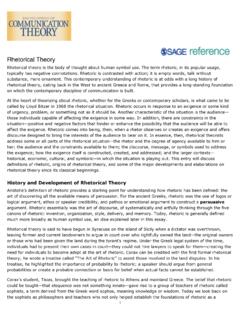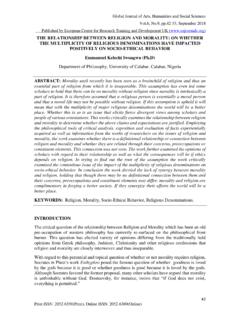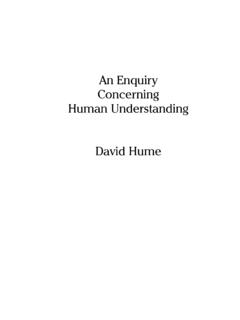Transcription of Introduction to Law Basic Concepts of Law - Kretschmer
1 Introduction to Law Basic Concepts of Law Basic Concepts What is law? Page 2 Historical development of Private Law Page 3 Working with rules Page 5 Working with cases Page 7 Generality/why study the law? Page 7 Legal system Page 8 Enforceability Page 8 Sources of Law Page 9 Important Concepts Page 10 Public Law The State Page 11 Human Rights Page 13 Constitutional Law Page 14 Administrative Law Page 14 Criminal Law Page 15 Procedural Law Page 16 Private Law Absolute Rights Relative Rigths Page 18 Individual Autonomy Page 18 Manifestation of Will Page 18 Legal Transactions Page 19 Contracts Page 19 Torts Page 20 Property Law Page 21 Business Entities Page 23 2 Basic Concepts What is law?
2 Do' s and Don ts Most people would agree that the law governs human behaviour by rules. It forbids certain ways of behaving, for instance stealing, killing or exceeding speed limits and prescribes others. For example paying taxes or driving on the right lane. Legal rules are also called norms. The law does not stop at setting up rules. It also secures compliance with them by threatening persons who disregard a rule with some disadvantage, like being imprisoned or having to pay money. This consequence is called a sanction. The task of the state is to put the sanction into effect, for instance to put the offender into prison or to take the money from him. We say: the sanction is enforced by the state.
3 Is and Ought The legal rules do not describe facts: they do not tell us anything about reality. Instead they specifies facts and describes what should happen if they are fulfilled. It says what ought to happen in certain situations and what consequences should follow if this does not happen. Example: If a newspaper reports: "Elfriede Blauensteiner was sentenced to jail for life for killing her husband", it describes facts. The relevant legal provision ( 75 StGB) says: "Whoever kills another person will be sentenced to jail for life or to be imprisonnend between 10 and 20 years". It has several effects: First, it prohibits murder; second, specifying that a murder has been committed, it describes what should happen to the perpetrator.
4 Right and Wrong Many people think that the law not only prescribes or forbids certain acts but also indicates what is right and what is wrong. But how do we know whether the rules set up by the law are fundamentally right?; how can we be sure that they are just? The Doctrine of Natural Law tries to answer this question by referring to meta-legal authority. According to its adherents law is correct if it conforms to the human nature (Plato), to divine revelation (Augustinus, Aquinas, John Duns Scotus, William Ockham) or to reason (Cicero, Grotius, Hobbes, Locke, Rousseau, Kant). The Positivist Doctrine accepts that we have no means of deriving law from a higher authority. It points out that the law is made up of social norms which are generally accepted and adhered to (Jellinek) or are formally enacted (Radbruch) or are regularly enforced (Austin, Holmes, Llewllyn).
5 Question: What are the aims of law? What do they provide? A lawyer's description Law-books usually describe the law as a system of rules enforceable by public authority requiring the members of a community to meet certain standards of conduct. They go on to 3 state that the law makes sure that the society remains stable and its members are able to pursue their interests and that disputes are settled efficiently. To this purpose the law should conform to public morality, without, however turning all moral norms into legal rules. Historical Development of Private Law Roman Law After the enactment of the Twelve Tables ( 450 ), a code that concentrated on the most important problems that had arisen under the customary law, a body of specialists called jurists emerged who studied the law systematically and practiced it by giving legal advice and by teaching.
6 Case by case approach they developed the fundamental legal Concepts ( obligation, property, pledge, contract, possession etc.) and the methods of formal and substantial reasoning. Formal reasoning works with the meaning of the words, parties' intent, legislative purpose, analogy, and logical conclusions. Substantial reasoning involves arguments based on values such as good faith, fairness (equity), public policy or practicability. It is important to notice that the jurists were no judges and their work was not concerned with the facts of the case; to ascertain the facts and to decide the cases was left to the judges; the jurists only gave legal opinions on which the judgment could be based. Emperor Justinian: Corpus Iuris Civilis By the end of the classical period of the Roman Law in the 3rd century AD the hundreds of law books and commentaries produced by the jurists had become totally unmanageable.
7 Around 530 AD the east-roman emperor Justinian compiled the material into four books, the Digest, the Institutes, the Constitutions, and the Novels, which where later labeled as the Corpus Iuris Civilis, a monumental work of about 1 Million words. Private Law in Western Europe After the decline of the Roman Empire the Roman Law remained formally in force but was in practice superseded by tribal laws and local customary laws. In the 12th century Irnerius, a professor of Grammar at the University of Bologna, started to work on the Corpus scholarly. He founded a school that became known as the Glossators. They started by analysing the meaning of the words and went on to uncover the underlying general principles and to examine the purpose of the rules.
8 Until the 15th century Roman Law spread to the universities all over Europe. Another school called the Commentators concentrated on adapting the findings of the Glossators to the practical problems of everyday life. They developed the Commercial Law and the International Private Law. During the same time Canon Law arose, the law of the Catholic church, which applied to clergymen and to laymen as far as marriages and wills where concerned. The graduates from the universities became judges or secretaries and chancellors to the rulers. Applying the Roman Law they had studied they gradually overcame the customary local laws. This process is known as the Reception of the Roman Law. The Roman Law as developed by the medieval scholars became Ius Commune, the common law all over Europe.
9 In modern times the idea of the sovereign national state emerged. The rulers aimed at establishing nationals laws within their territories. It was again the scholars that worked out national codes on the basis of Ius Commune and the rationalist natural law doctrine that had been developed since the end of middle ages. The ideal of a code was to present the law in 4 such a way that any legal question arising out of any situation could be solved by referring to the text without giving the judge too much discretion. To achieve this purpose the legislators used abstract Concepts and principles which desribe the characteristic features of the legally relevant situations in everyday life (eg exchange of property, damage to physical integrity or to property, marriage, last will and many others).
10 The first great codification was Prussian Code of 1794, followed by the Code Napoleon of 1804 and the Austrian Civil Code of 1812. These codes reflect the spirit of enlightenment and rationalism, of equality of the citizens, freedom of private legal relationship from state control and freedom of economic activity. After almost a century of further intensive academic activity the German Civil Code of 1900 and the Swiss Civil Code of 1907 followed. Their philosophical and ideological foundations are similar to those of the elder codes again stressing freedom and equality of the citizens as well as private autonomy. Both these codes carried abstractio so far that they had the effect - unintended in the case of the German Code - to give the courts large leeway to adapt the law to the difficult social and economic conditions of the early 20th century, thereby creating an extensive body of case law.








